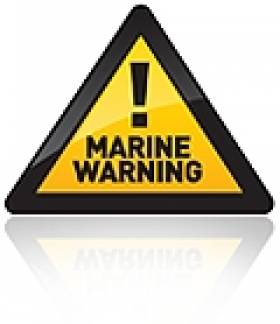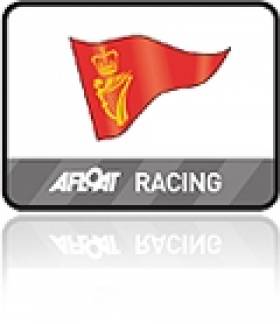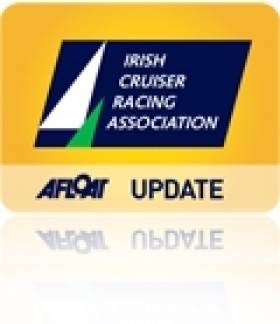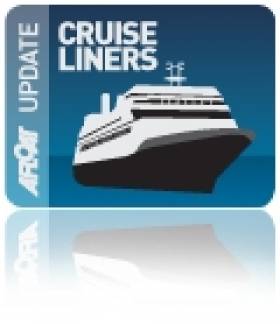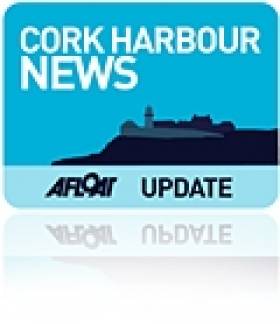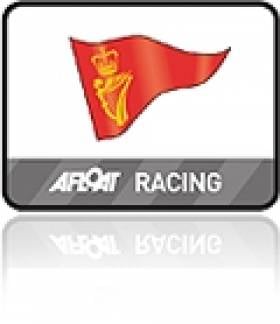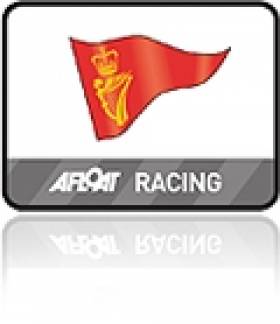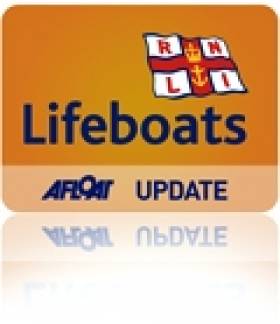Displaying items by tag: Cork Harbour
Coastal Areas Braced for Flood Risk Tonight
A combination of high tides, high winds and low pressure increase the possibility of coastal flooding, particularly at high tide around midnight on Sunday 7 November and midday on Monday 8 November.
A deep low pressure centre is expected to move down across Ireland tonight, clearing away slowly during Monday. This weather system has the potential to bring some severe weather to Ireland. Rainfall totals are likely to reach 25mm - 30mm in places during Sunday and Monday. While not excessive, this rain may lead to some localised flooding on roads. The strongest winds associated with this weather system are likely to be well to the west of Ireland; however if the track of the low pressure is further east than currently expected, then these very strong winds may possibly affect our west coast.
The principal dangers from this weather system will be due to very high seas off the southwest and west coast (waves approaching 9m) and coastal flooding due to a combination of high tides, very low pressure, storm surge and onshore winds. The danger period extends through Sunday night and, for the east coast, much of Monday also. Valid from: 12hrs Sunday Nov 7th To: 06hrs Tuesday Nov 9th.
Householders, property owners, motorists and pedestrians are warned that there is a risk of coastal flooding in Dublin in the next 36 hours according to a Dublin city council update issued last night.
More from Cork City Council HERE
More from Dublin City Council HERE
On the Forum: Dry Sailing at Royal Cork
A dry sailing facility would make the Royal Cork Yacht Club one of the best in the world. It's a pity it may be too expensive, says Patton. It is a pity too about the lack of highly competitive racing in a club full to the brim with seriously talented sailors, he says. Read more HERE
Panz is looking for help identifying a location of a sailing venue. A photo shows a National 18 on the hard at a clubhouse that might be in Derry? Can you help identify this club house? HERE
Kinsale Yacht Club Announces 2011 Sovereign's Cup
Details of the 2011 Sovereign's Cup were announced at a reception at Kinsale Yacht Club, hosted by Regatta Director, Gary Horgan. The Sovereign's Cup takes place from 22nd-25th June 2011 in the outer harbour of Kinsale which prides itself with excellent sailing conditions, as well as an extensive social programme ashore.
The Sovereign's Cup was established in 1995 as a biennial event and has been a very successful and hugely popular cruiser regatta, with over 140 boats from all over Ireland and the UK competing for the prestigious Sovereign's Cup for best all round score in IRC and The Portcullis Trophy for best progressive handicap.
There are many Classes for entry; including Class 0, 1, 2, 3, 4 and two White Sails classes. Also, the Quarter Ton Class Championships will be taking place during the Sovereign's Cup, bringing many new visitors to Kinsale from the South of England and Wales in particular.
Eamonn Rohan in Blondie IV a Mills Design King 40, claimed the 2009 Sovereign's Cup as the 2009 Portcullis Trophy was awarded to Chapman / Reilly's Crazy Horse. Anchor Challenge captured Class 3-IRC and the Quarter Ton Class and was awarded the Keane's Jewellers Quarter Ton Perpetual Trophy.

The Kinsale Yacht Club committee behind the 2011 Sovereigns Cup
"We have already received a number of entries for The 2011 Sovereign's Cup in June and we will be stepping up our sponsorship and communications programme as the months advance," said Gary Horgan, Race Director. "We are very grateful to Kinsale Yacht Club, the Race Management team and all the volunteers who get involved with the organisation of the Sovereign's Cup as we are working hard to organise an excellent programme both on and off the water. We are encouraging people to start thinking about their travel and accommodation plans and are delighted that the Cork Swansea ferry will enable more sailors to access Kinsale easily from the UK," he added.
Weather Gods at Play for October League Finale
Arriving at the Royal Cork Yacht Club yesterday for the final day of the O'Flynn Exhams Autumn League there wasn't a puff of wind to be felt writes Claire Bateman. The Club Burgee hung limply and the general consensus of competitors on the marina was that there wouldn't be any wind. However, lo and behold as the boats went out into the harbour wind was blowing from the south and spirits (not the Halloween Spooks) lifted immediately. PHOTO GALLERY HERE.
Race Officer David O'Brien in Admiral Paddy McGlade's Sabrone anchored off Whitegate and set a course a course for the Red Fleet out to the mouth of the harbour starting Class Two first and this was great as they were followed by the 1720s and in turn by the higher rated boats of Classes Zero and 1. This made for a great intermingling of the fleets in the harbour. Starting just after the top of the tide and with a southerly breeze this was a help to the boats on the beat as they tacked to and frow some favouring the western shore but the majority favouring the eastern shore. Conditions got a bit lumpy with the wind over tide and steeped up by a ground swell. There were a couple of showers but considering the summer like conditions that had been enjoyed for the series nobody was going to bother about this. After each shower cleared there was the most amazing light on the fleets and rainbows added more punch to the colour of the spinnakers.
In race 2 there was an incident on the line in Class 1 when there was a coming together of Mary O'Keeffe's Tux and Wan and Eric Waterman's Saxon Senator resulting in Senator's retiral. Also in the Red Fleet there were six boats disqualified for sailing the wrong way through the finish line – perhaps more reading of the Sailing Instructions required!!
Race Officer Richard Leonard in Pascal Healy's Capta Ventum anchored off Cuskinny to sail the Green Fleet on the laid courses. Richard, perfectionist that he is, complained bitterly that the wind had shifted some 20 degrees after the start and when sailing multi fleets particularly on a short course it would be extremely difficult to shift the marks. Nevertheless he got in two good races.
In Class 3 there was very keen competition between Ian Travers in Bandit and the Kenefick O'Brien favourite Tiger and they shared a first and second each on the day. However, Tiger triumphed overall by a winning margin of 2 points after 10 races. Newcomer to racing Fergus Coughlan in Whyte Knight had two wins on the day in Class 3 ECHO ensuring his overall andpopular win in this class.
IN Class 4 ECHO Michael Murphy in Shelly D created his own bit of sailing history when sailed his boat to victory in this class. He had sailed Shelly D in the October League for 31 consecutive years and received a a tremendous ovation for his efforts. However, in Class 4 IRC there was no stopping Alan Mulcahy in Sundancer from taking the overall prize with 7 wins and 2 seconds.
In White Sail 1 IRC Tom and Conor McNeice in Minx 111 had two thirds yesterday and this was enough to give them the overall win in the class. The Carroll Bros. In Chancer had two wins yesterday but ended up seond overall.
In White Sail 2 IRC Clive Doherty's Phaeton made a late challenge winning both races and this was enough for overall victory over Roy Hanan's Plumbat.
The prizegiving took place in a packed dining room after a very enjoyable meal. The prizes were magnificent, and were presented by Richard Neville, Managing Partner from the excellent sponsor O'Flynn Exhams Solicitors, aided by Admiral Paddy McGlade and Regatta Director, Rear Admiral Ronan Enright. Irene O'Donovan also a partner from the sponsor company, was present with her husband Pascal Healy who had provided the committee boat for the laid course and who were both on board for the series.
A most successful series was enjoyed by all and sundry and not forgotten in the acknowledgements were the club volunteers who had given freely of their time and effort to make the event the memorable Autumn League that it was.
Marinerscove Takes Narrow Lead in 'Boat of the Year' Opinion Poll
Marinerscove leads Afloat's sailing Boat of the Year opinion poll that has attracted over 1700 votes to date. After 20 days of voting the lead has changed several times in the fun poll and early leader Erisslanan, who shared boat of the week with Mariners at Cork week is now in third place on 227 votes, some distance behind ISORA winner Raging bull on 607 votes. 81 votes clear ahead is the Crosshaven boat that also bagged the British IRC title this year. Dave Dwyer's Marinerscove was of course also the middle boat in the victorious Irish Commodores Cup team in August. The ICRA boat of the year award will be awarded on November 13th at the Cruiser Racer conference in Carrigaline. You can vote by using the poll on the left hand side of Afloat's home page.
Over 100,000 Cruise Passengers Visit Port of Cork in 2010
2010 proved to be another busy year for the Port of Cork with a total of 52 cruise liners calling to Cobh, Ireland's only dedicated cruise berth.
Onboard the 52 cruise liners were a total of 100, 414 passengers and crew, a record number to visit Cork.
Following the Port of Cork's investment in Cobh's dedicated cruise berth over the last five years, some of the largest liners in the world are now capable of berthing, bringing with them thousands of passengers and crew, all of whom contribute to the local economy. With a ambitious target to grow the cruise business even further, the Port of Cork are aiming to increase the number of cruise liner calls over the next five years to seventy-five.
Speaking at a recent Port of Cork cruise seminar entitled Achievement of growth in the cruise business in Cork, Captain Michael McCarthy, Port of Cork Commercial Manager said: 'We are keen to grow the business even more over the next five years. This will mean further investment of Cobh Cruise berth from the Port of Cork to handle even larger ships and to increase the number of current overnight stays.'
He continued: 'While the Port of Cork is committed to investment in this area we recognise that the region is the biggest benefactor from this business and we would therefore encourage the local authorities and organisations to support this investment.'
In a recent study carried out by UK cruise consultants, GP Wild, the on average spend per in-transit passenger is approximately €73 per day while in port. Captain McCarthy commented: 'With so many passengers arriving into Cobh and Cork, the impact that this has on the local economy is very positive.'
During the cruise seminar Captain McCarthy talked about Cork's potential as a cruise capital saying that: 'Feedback from cruise companies visiting Cork is very positive. Direct access to the quayside for passengers coupled with the accessibility of trains to Cork and the historic town of Cobh and its attractions on their doorstep, makes Cobh an attractive port of call. However tour operators and shore side attractions must all work together to offer passengers exciting full and half day tours, while also making it a memorable experience so that they may return.'
Also speaking at the Port of Cork cruise seminar was Clare Newman Port of Dover, Paul Ellerby UK Cruise Consultant and Aiden Pender Failte Ireland.
Since 1991 Port of Cork passenger and crew numbers have grown by nearly 85,000, highlighting the rapid growth of the sector which is predicated to continue. Cruise bookings for 2011 have already exceeded 2010 calls and potentially could be the busiest yet for the Port of Cork.
The 2011 Port of Cork cruise bookings list will be available at www.portofcork.ie at the end of January 2011.
Military Vessels Call to Cork Harbour
A number of Military vessels are in Cork Harbour this weekend and moored at Kennedy and Horgan Quays in the city centre. The ships include the Estonian 52 metre Naval/Military Ship Admiral Cowan, the 55m Norwegian Hinnoey and two Polish Military ships the 78 metre Orp Czernicki and the smaller 55m Mewa. Tasks conducted by the Mewa include scout and control minesweeping, minefield clearing, setting safe routes as well as guiding ships and groups of ships through mine endangered zones, laying bottom and moored mines,
Tiger Leads Class III in Royal Cork October League (PHOTOS HERE)
What a day this Sunday's racing turned out to be. From the moment one turned the corner on to the Crosshaven road at Carrigaline there was magic in the air writes Claire Bateman. The sun was shining, the trees were resplendent in their multi colour seasonal changes and the line of cars making their way to the Royal Cork Yacht Club was non-stop. The forecast said Sunday was going to be a very nice day with lots of sunshine but nowhere did I hear anyone say anything other than winds would be light and, so it seemed, until a flag outside one of the supermarkets on the road to Carrigaline seemed to be moving pretty nicely and was a taste of things to come.

Tight racing in the penultimate race of Royal Cork's October League. Photo: Bob Bateman. Scroll down for more photos from yesterday
Classes Zero, One and 1720s got the nicest wind on the laid course to day. Race Officer Richard Leonard and his race committee in Capta Ventum, kindly provided by Pascal Healy, certainly made the best of the day. Today Richard decided on a change of format and started the 1720s first followed by Classes Zero and One together and then Class Two. He gave the fleets short courses providing very tight racing ensuring the crews had plenty of hard work and also providing very exciting viewing with a few heart-stopping moments. The 1720s, Zero and One did three rounds and Class Two did two rounds. With a northerly breeze of some 10 knots gusting to 12 and occasionally 14, it was to provide a tantalising taste of what was to come and there was no disappointment. Voices that hadn't needed to be raised at marks on previous Sundays found the necessity to make themselves heard today and the action was fascinating with hard work on the boats but a sense of great sailing exhilaration emanating from them.
Coming into race two of the day the skippers and crews had got the bit well between their teeth and were all like bucking broncos at the start line. In Class Zero there was an individual recall sounded. Jump Juice and Freya answered the call immediately and returned to restart and after some little while Gloves Off returned and while not knowing the reason why, one can only assume the helmsman perhaps was not quite convinced he had been over but then decided to return having considered it. Again the wind duly obliged and as in the first race, there were boats to the left, boats to the right and boats pretty well everywhere one looked. In Class Zero Tom Roche's Meridian from Kinsale had been performing extremely well but was slightly under
crewed today and was unlucky enough to have an incident at the weather mark in this race and after that things just did not go their way and they retired. This must have been disappointing as they had been doing so well. With Jump Juice winning the first race today and Gloves Off taking the second race and first overall to date in the series, the last day of racing next Saturday will be crucial as these races will be non discardable.
Race Officer Anthony O'Leary stood in to day for David O'Brien and the committee boat Sabrone was again kindly provided by Admiral Paddy McGlade. It was not such a lucky day wind wise inside the harbour for Classes Three and Four and White Sail 1 and 2. There was also extremely low water to day
and some of the skippers mentioned they had in fact touched rocks. Nonetheless they enjoyed good racing if at a somewhat lower pace than the competitors on the laid course.
At this point in time Class Three IRC looks like a two horse race with Tiger on 9pts followed by Bandit on 11pts. Class Four has a very similar situation with Sundancer on 9pts followed by Granny knot on 11pts. In White Sail 1 IRC Minx 111 had a good day to day with a first and second and currently has 7pts overall and the two big boats in the fleet Chancer from Kinsale and Aisha from RCYC are on 14pts each. In White Sail 2 IRC Plumbat is on 6pts overall with Phaeton on 9pts and Silk Breeze on 12pts.
And so we are coming to the final race of this exciting series. All competitors should note carefully that racing will take place on SATURDAY NEXT OCTOBER 30TH. The prize giving dinner will take place that evening at the Club House .
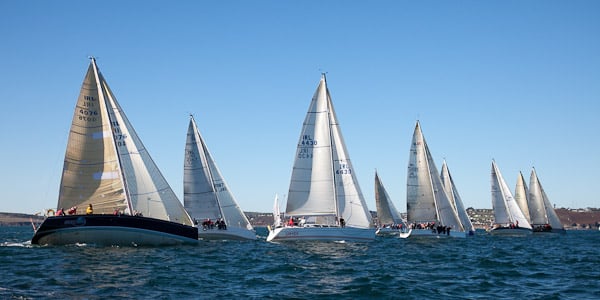
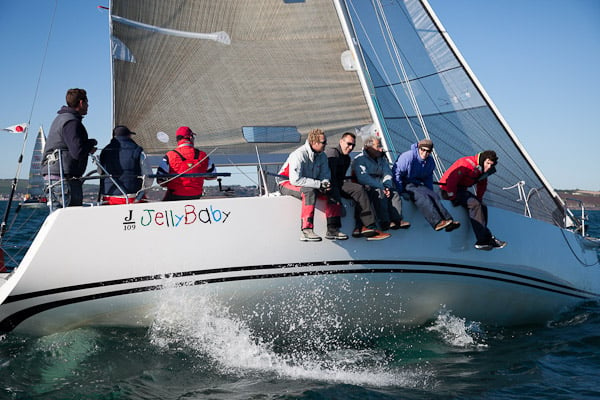




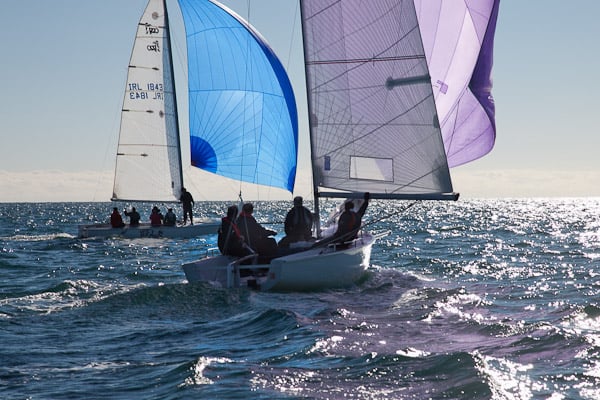
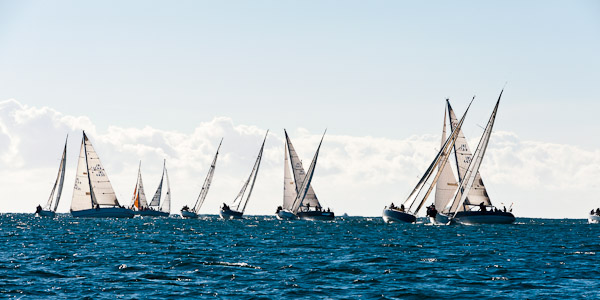
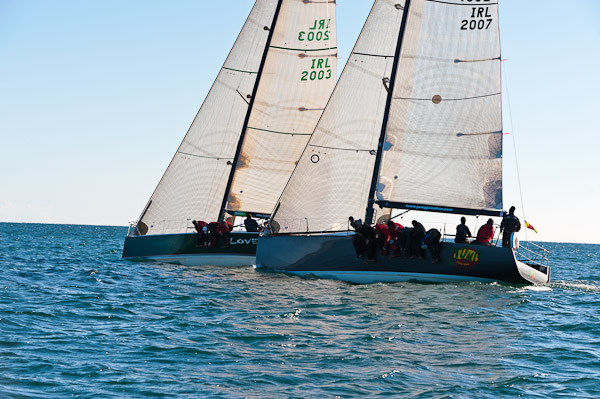
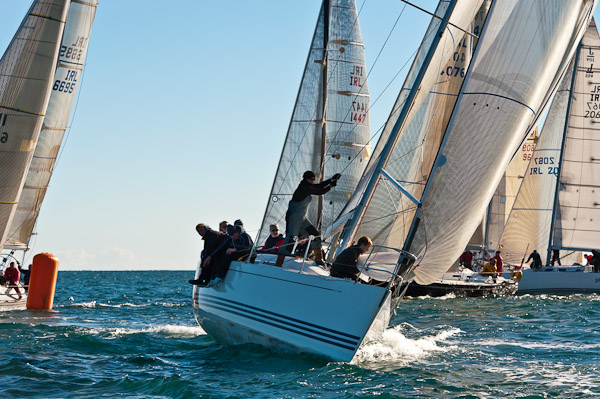
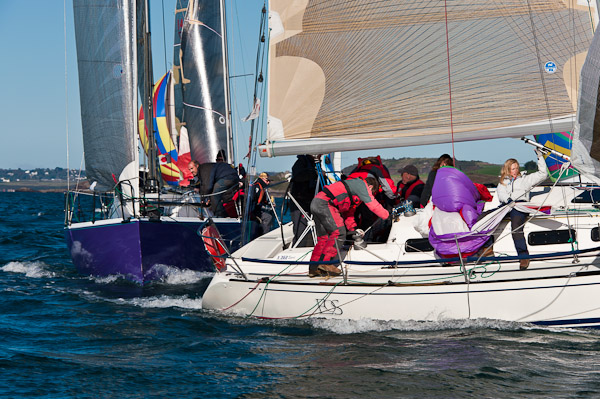


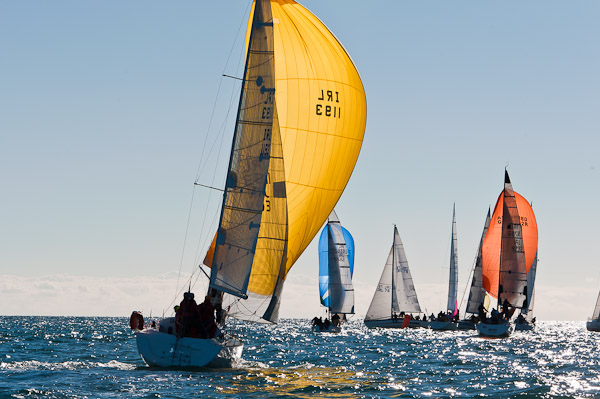
MORE OCTOBER LEAGUE GALLERY IMAGES HERE
Latest Photos From Royal Cork's October League
Bob Bateman's latest photos from yesterday's Royal Cork's October League are over the fold. Having sailed six races in the O'Flynn Exhams Autumn League and, with a discard applied, a trend is emerging writes Claire Bateman. The exception to this is White Sail 1 and 2 who have had four races and at the wish of the classes have reverted to two races each day. It was another light day with yachts waiting patiently for the breeze to fill and when it did it was a light breeze from the west going further into the south as the day went on. Richard Leonard's Green Fleet were on a laid course outside the harbour and having postponed the first race during the start sequence, he eventually got the fleet going when the west breeze settled. Class Three and White Sail 1 were started together followed by Class Four and White Sail 2. The mixing of classes made for interesting racing as it kept the boats in close proximity to one another and a second race was sailed successfully thereafter.
On David O'Brien's harbour course with the Red Fleet the breeze was slower to fill in. However, when it did Class 2 and the 1720s were sent on a course to Ringabella against the flood tide. The Class Zero and Class One fleets were over eager and suffered a general recall so they started last. Again they were over anxious and were bunched at the pin end of the line but after some manoeuvering a clear start was called and they too set off for Ringabella, the boats heading for the western shore to avoid the tide faring best. First to reach Ringabella was Jump Juice but she obviously didn't feel like leaving as she clung to the mark having to suffer the fate of watching many of the class rounding before she eventually got free. In Class One IRC Donal O'Leary's D-Tox is on 7 points but David Scott's EOS is on 20 points with Michael Wallace just one point adrift on Felix.
The position in Class Three IRC appears to be the most obvious with the prowling Kenefick/O'Brien Tiger leading with five first places followed by Ian Traver's Bandit on 9 points and in Class Zero IRC the same equally obvious situation pertains with Kieran Twomey's Gloves Off on 5 points and Conor Phelan's Jump Juice on 9 points. In Class Four IRC Mike Sexton's Granny Knot and Alan Mulcahy's Sundancer are tied on 7 points each.
This league is also counting for the SCORA 2010 League as is the April league from Kinsale a total of fifteen races overall with three discards so this also adding spice and competition to the event.
To-day's day prizes were presented by Eamonn Muldoon of O'Flynn Exham's and racing will continue next Sunday with first gun at 10.55 am.
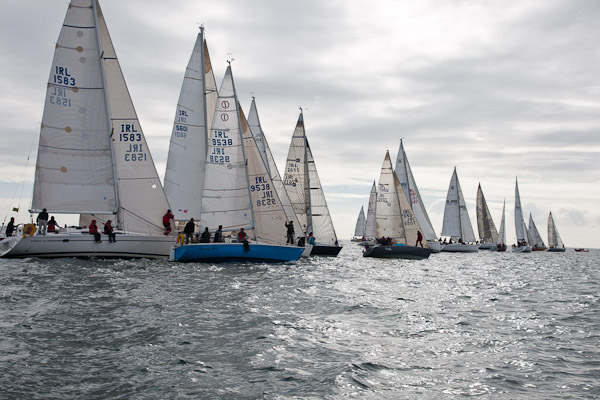
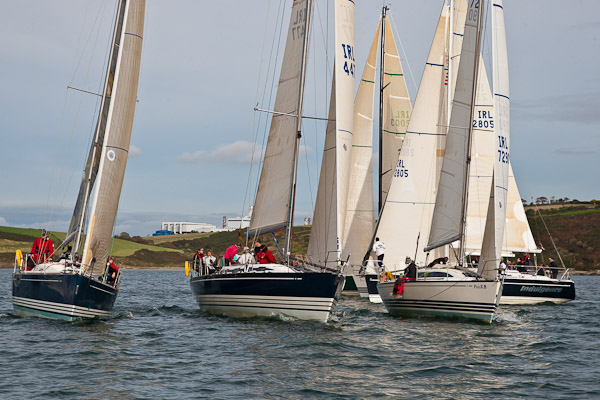


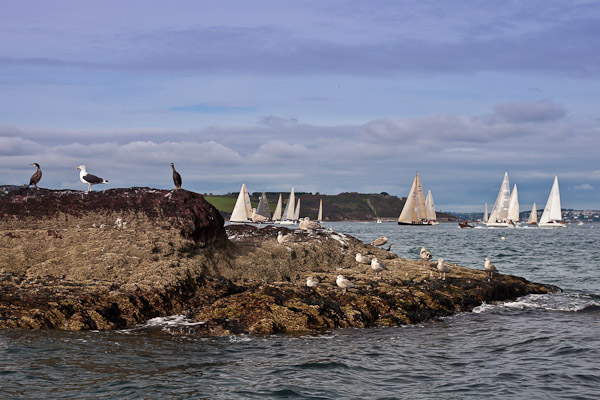


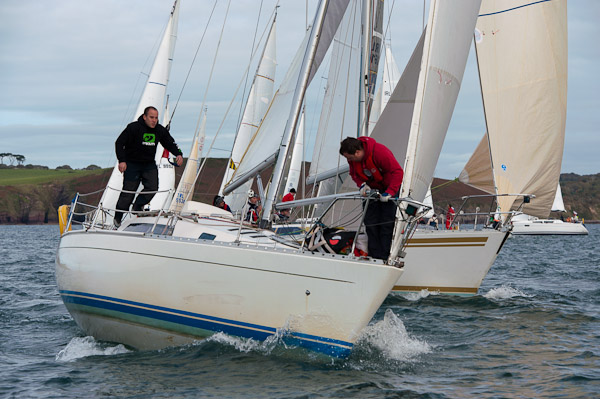

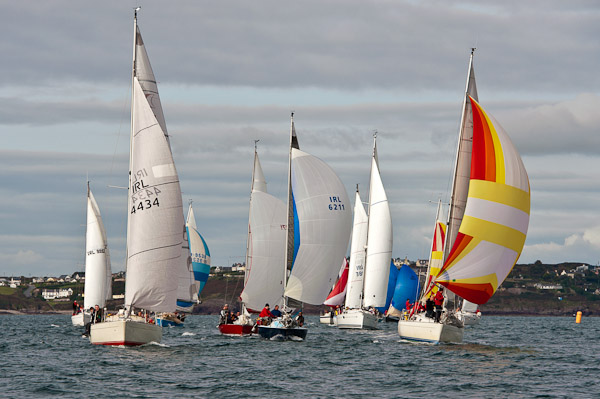


Ballycotton Lifeboat Rescues Fishing Vessel
Ballycotton lifeboat was launched last night, 11 October, to a fishing vessel with a fouled propeller, near rocks off Ballycroneen Bay, east of Cork Harbour. The boat's skipper put out an anchor and contacted the owner, who in turn contacted the lifeboat station. Ballycotton lifeboat was launched at 19:55 and arrived on-scene at 20:15. They pulled the fishing vessel away from the rocks and any possible fishing gear that was in the area. A tow line was established and the fishing vessel was towed into Ballycotton harbour, arriving at 21:20.
Related Safety posts
RNLI Lifeboats in Ireland
Safety News
Rescue News from RNLI Lifeboats in Ireland
Coast Guard News from Ireland
Water Safety News from Ireland
Marine Casualty Investigation Board News
Marine Warnings


























